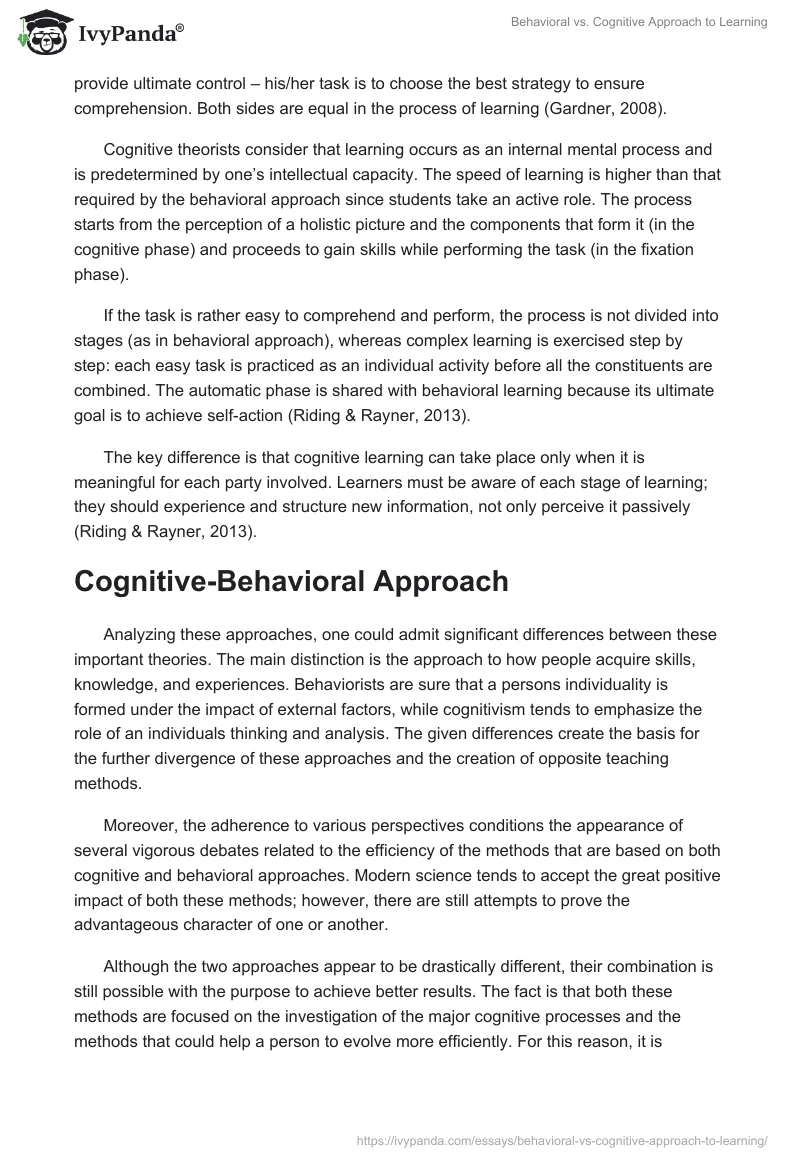Behavioral Approach
This approach relies on the idea that in the process of learning, students respond to various stimuli from the external environment. Thus, according to behavioral theory, the role of an educator is to provide useful stimuli that can lead to the formation of the desired behavior (Skinner, 2011).
Behavioral learning theorists believe that learning revolves around the continuous repetition of the same action that is accompanied by appropriate feedback on behalf of a facilitator (Skinner, 2011).
In the most general terms, learning is considered to be successful if the change in behavior happens as a result of proper conditioning. The process of learning is rather slow in this case because the required result takes time to achieve. First, the behavioral pattern must be introduced and established, then – consistently maintained. Complex learning falls into a series of small successive steps that have to be repeated until the reaction is automatic (Jonassen & Land, 2012).
The approach also relies on the assumption that there exists only one correct way of doing something, one “true” answer that students must know. Further, it disregards the peculiarities of each learner. Therefore, a facilitator receives unlimited control over the learning process. He/she is free to choose any means to reach the required objectives (Skinner, 2011).
Cognitive Approach
Unlike behaviorism, which concentrates on the importance of the educator’s role (with students as passive recipients of information, who are supposed to react in a prescribed way), the cognitive approach is more concerned with the learner’s mental activity in generating ideas and educational opportunities. The teacher should not provide ultimate control – his/her task is to choose the best strategy to ensure comprehension. Both sides are equal in the process of learning (Gardner, 2008).
Cognitive theorists consider that learning occurs as an internal mental process and is predetermined by one’s intellectual capacity. The speed of learning is higher than that required by the behavioral approach since students take an active role. The process starts from the perception of a holistic picture and the components that form it (in the cognitive phase) and proceeds to gain skills while performing the task (in the fixation phase).
If the task is rather easy to comprehend and perform, the process is not divided into stages (as in behavioral approach), whereas complex learning is exercised step by step: each easy task is practiced as an individual activity before all the constituents are combined. The automatic phase is shared with behavioral learning because its ultimate goal is to achieve self-action (Riding & Rayner, 2013).
The key difference is that cognitive learning can take place only when it is meaningful for each party involved. Learners must be aware of each stage of learning; they should experience and structure new information, not only perceive it passively (Riding & Rayner, 2013).
Cognitive-Behavioral Approach
Analyzing these approaches, one could admit significant differences between these important theories. The main distinction is the approach to how people acquire skills, knowledge, and experiences. Behaviorists are sure that a persons individuality is formed under the impact of external factors, while cognitivism tends to emphasize the role of an individuals thinking and analysis. The given differences create the basis for the further divergence of these approaches and the creation of opposite teaching methods.
Moreover, the adherence to various perspectives conditions the appearance of several vigorous debates related to the efficiency of the methods that are based on both cognitive and behavioral approaches. Modern science tends to accept the great positive impact of both these methods; however, there are still attempts to prove the advantageous character of one or another.
Although the two approaches appear to be drastically different, their combination is still possible with the purpose to achieve better results. The fact is that both these methods are focused on the investigation of the major cognitive processes and the methods that could help a person to evolve more efficiently. For this reason, it is possible to speak about the possibility to elaborate some integrated approaches based on the combination of the above-mentioned approaches.
However, such type of combination is more generally applied in psychology. The approach focuses on the development of personal strategies of learning that would solve emerging problems and change ineffective patterns of cognition. It is both purpose-focused and action-oriented, which means that it allows students and teachers to choose the most suitable method of learning new information. Therefore, it is possible to resort to repetition and reinforcement as well as give students more freedom of choice and encourage their ideas when they can contribute to the ultimate result. The key point here is flexibility and openness to variations.
However, in practice, it requires much more effort on behalf of the educator because it is much harder to implement than either of the two theories taken separately (Jonassen & Land, 2012). In this regard, despite numerous differences between these approaches, there are still opportunities for their combined usage that come from some similarities.
References
Gardner, H. (2008). Art, mind, and brain: A cognitive approach to creativity. New York, NY: Basic Books.
Jonassen, D., & Land, S. (Eds.). (2012). Theoretical foundations of learning environments. London, UK: Routledge.
Riding, R., & Rayner, S. (2013). Cognitive styles and learning strategies: Understanding style differences in learning and behavior. London, UK: Routledge.
Skinner, B. F. (2011). About behaviorism. New York, NY: Vintage.


